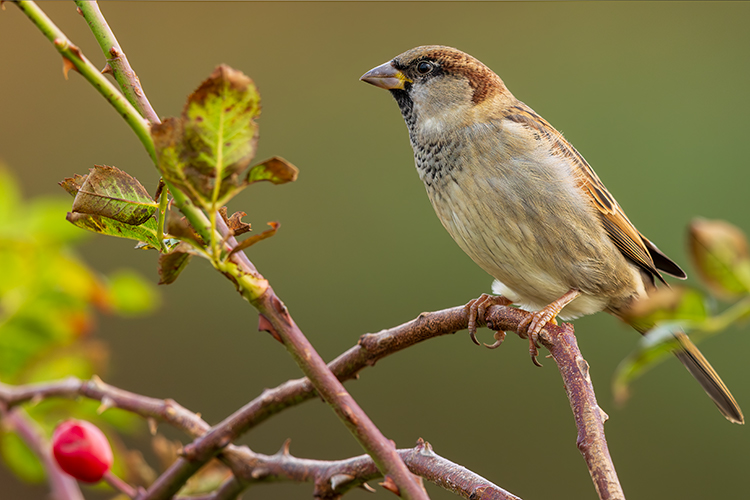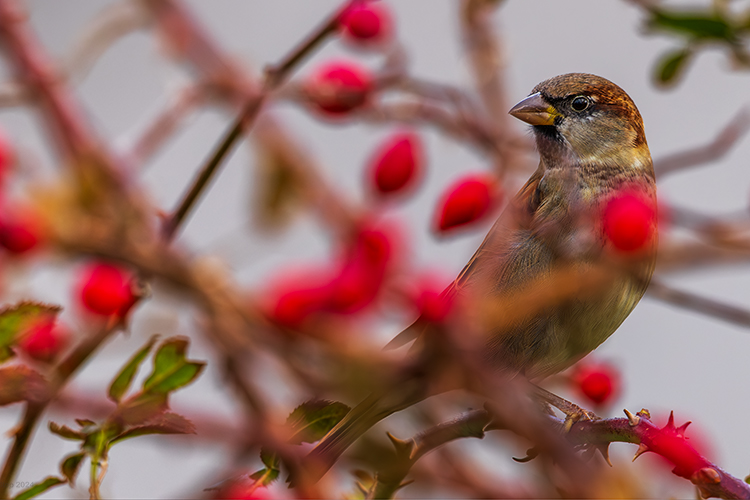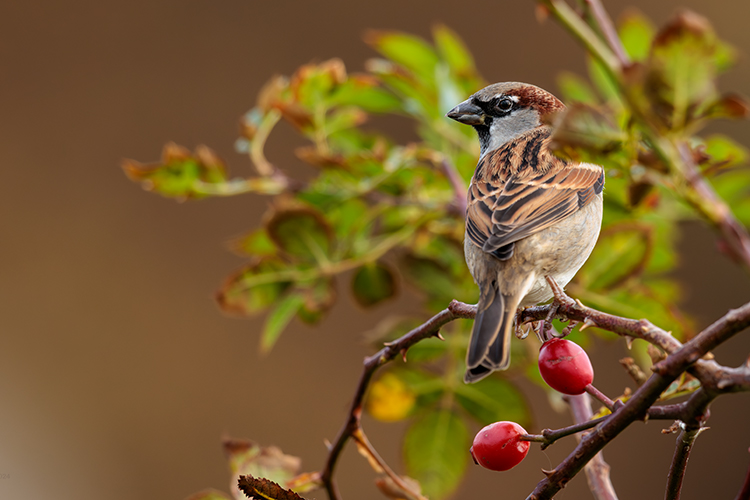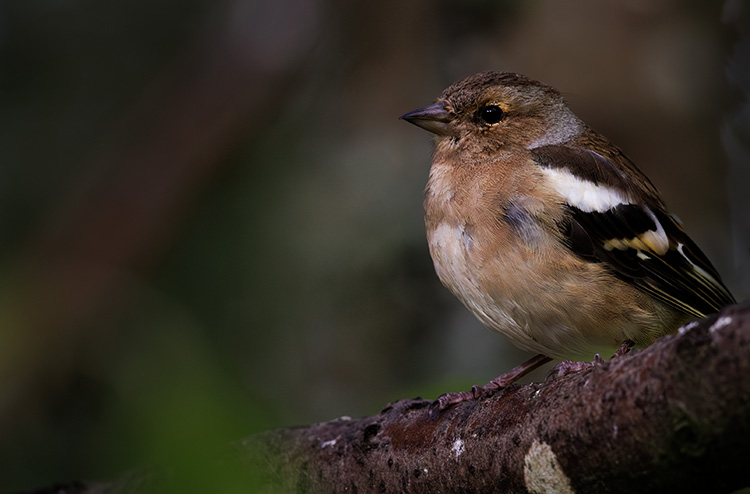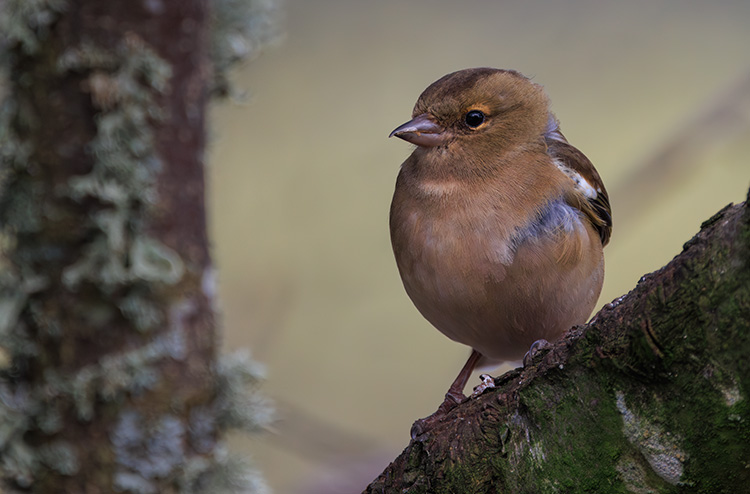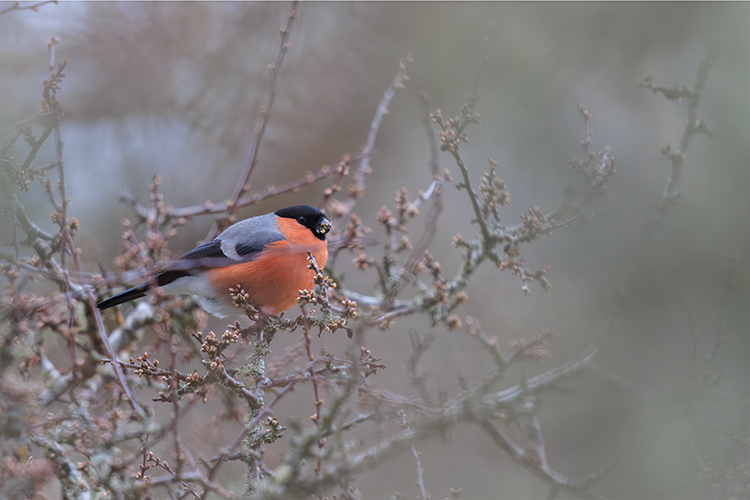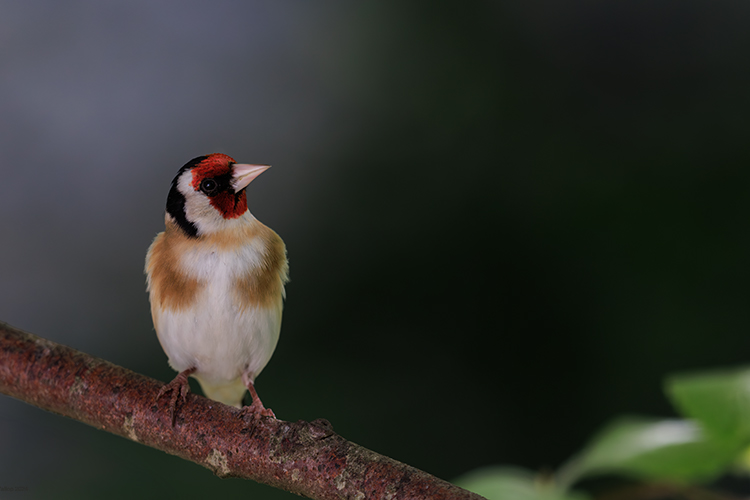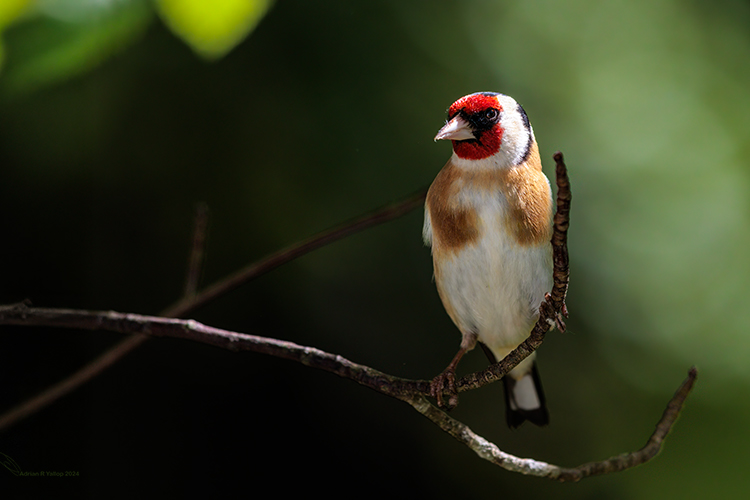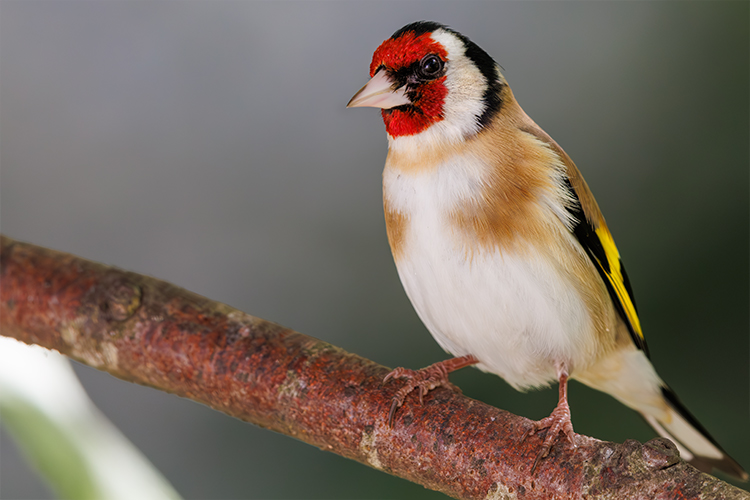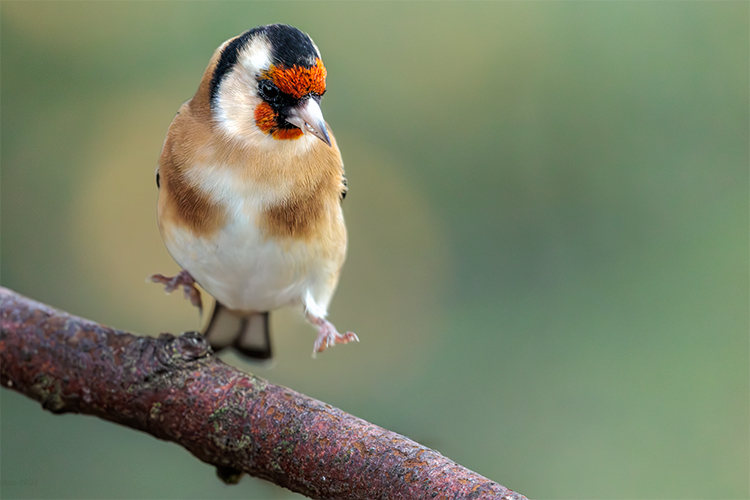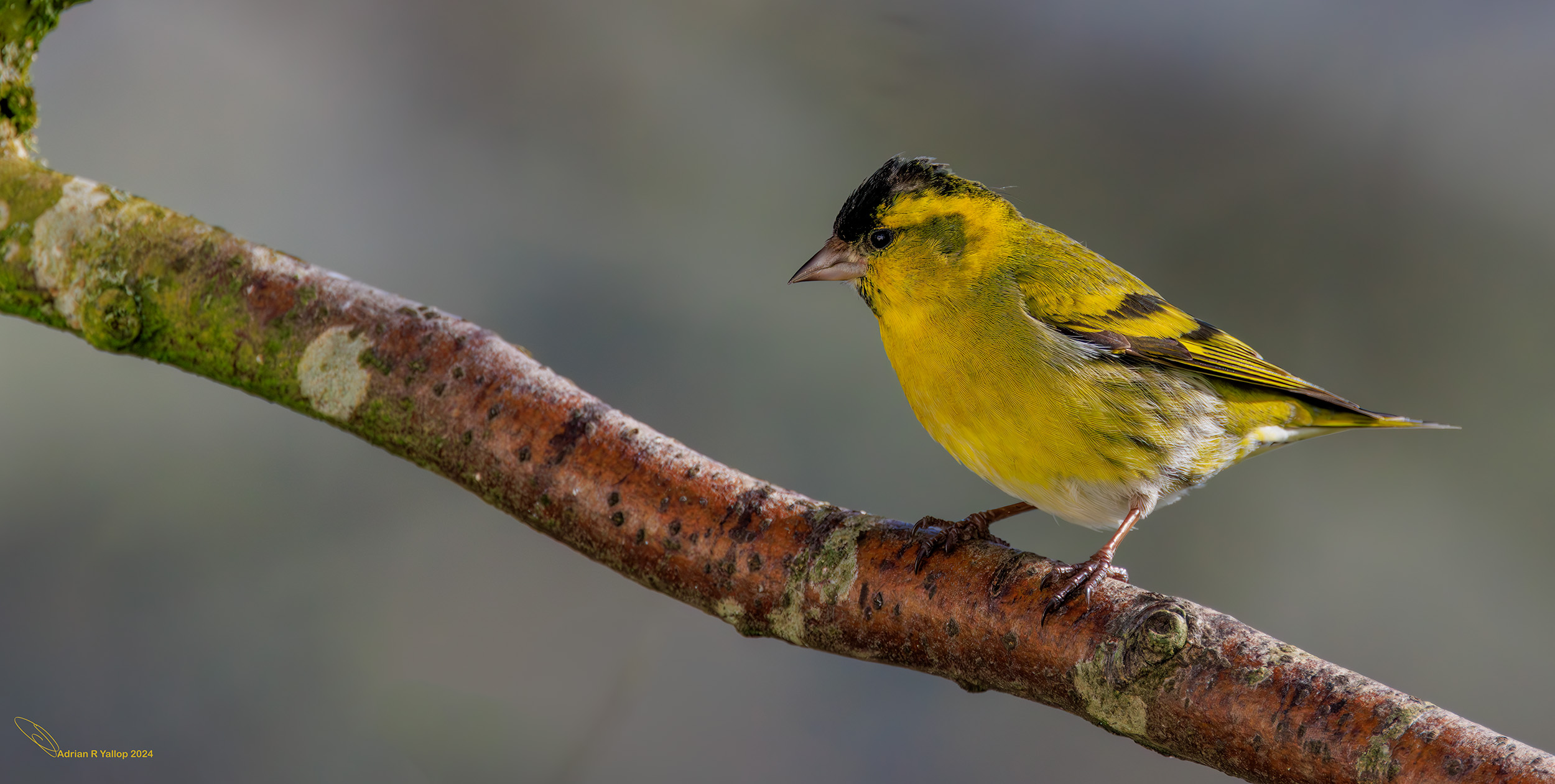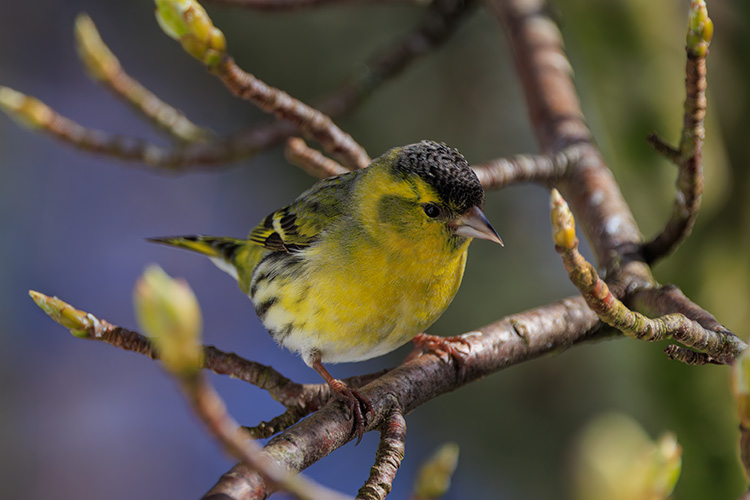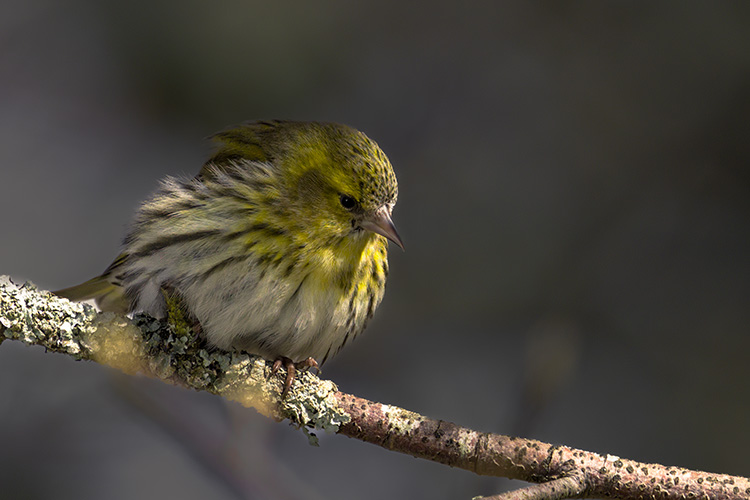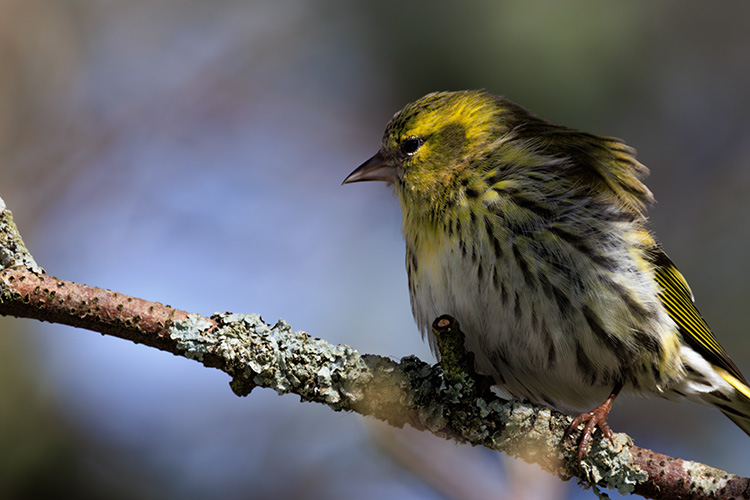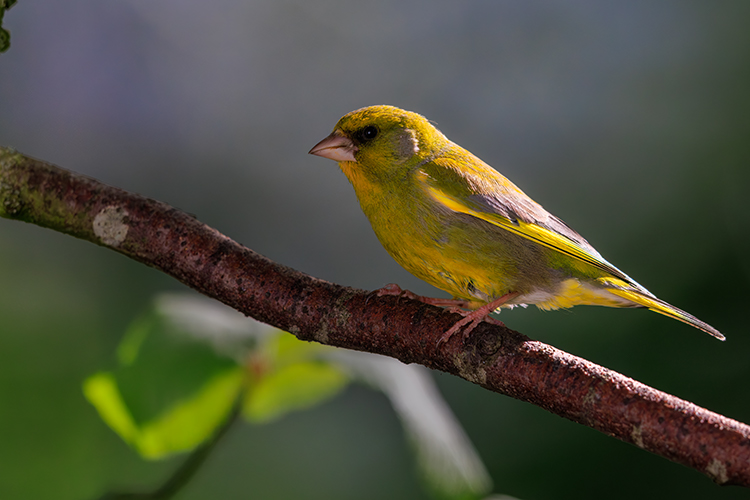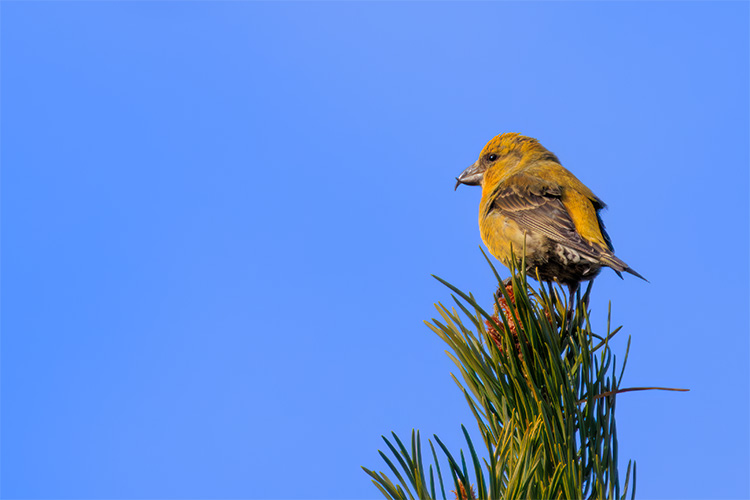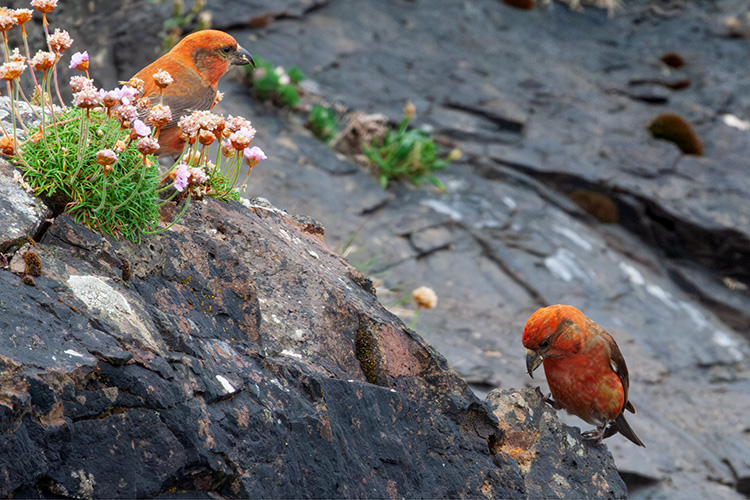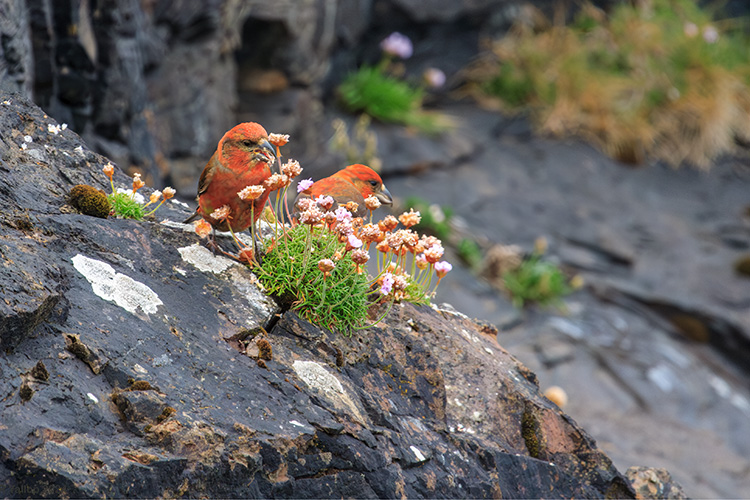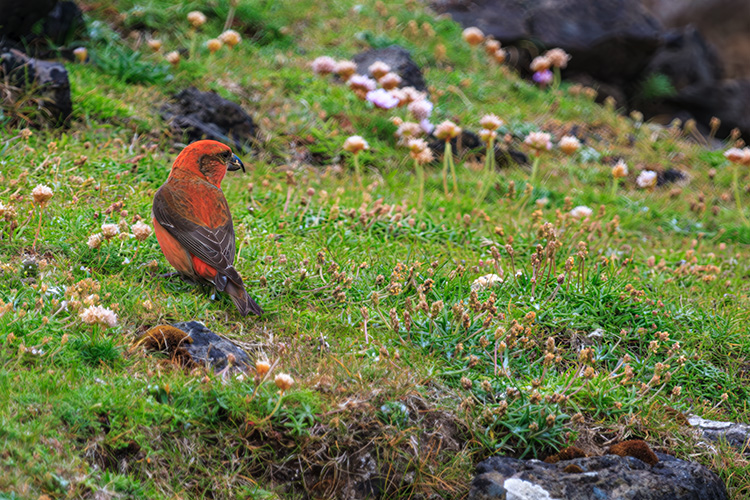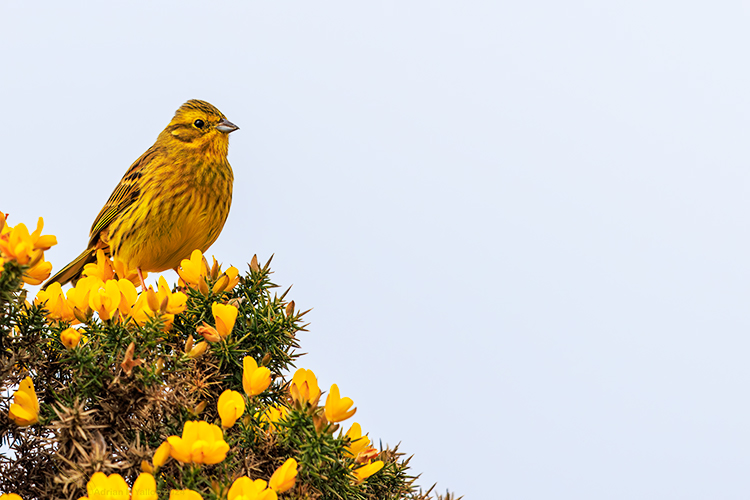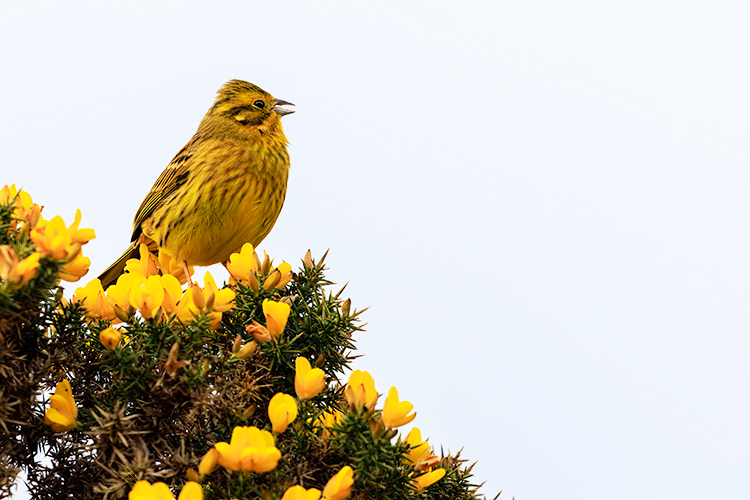
House Sparrow Passer domesticus
Sparrow is apparently derived from the Anglo-Saxon spearwa , with roots from the Icelandic Sporr meaning ‘Flutterer’. This is also the basis for a number of local names inc: Spadger, Sprig, Sprug, Sprong (variously: Roxburgh, Perth, East Lothian) and Spyng (Kirkcudbright).
Aka: Craff (Cumberland), Row-Dow or Roo-Doo (Northants), Thatch or Thack Sparrow (Northants, Salop), and Easing Sparrow (Salop: from eaves) and Philip or Phip from its call.
As a once common bird, and one associated with human habitation, it has a bit of folklore with which I can regale (?) you. In Kent, it was believed that if you caught a Sparrow you must not leave it alive, otherwise the parents of the catcher would die. Now, as there strangely appears to be no time limit on this one, it is another sure-fire prediction. Sparrows have also been credited with prophetic powers:
" Look, my dear " said S's wife to him one morning as he lay in bed. "look at that kite flying round the room! ” He saw nothing, but heard a noise like a large bird flapping its wings. A few minutes afterwards a sparrow came, dashed its bill against the window, and flew away again. " Oh! .... " said Mrs. S. " ..... something is the matter with poor Edward " (her brother ). She had hardly said the word when a man on horseback rode up and said, when S. opened the door to him, " Don't frighten poor Mary, but master has just expired ! " The messenger had only ridden from Somers Town to Compton Street , Soho.
Kelly (1863) in Curiosities of Indo-European Folk-Lore, pp. 104 , 105. says that he had this story from ‘S’ himself who was possessed of the notion that the sparrow that tapped at his window was the soul of his brother-in-law ".
I am not sure what this tells us about the beliefs of earlier folk really, but I do note that the chapter following this is covers ‘The Psychopomp of Cows and Dogs’. Yes, yes, I had to look that one up, and it’s derived from the Greek for the ‘guide of the souls'. In Jungian psychology it is also apparently a mediator between the unconscious and conscious realms. Now that’s an odd circular coincidence, because I think psychology is basically the same as the stuff you find laying steaming on the ground behind male cows. Anyway, in this chapter is a bit on ‘death omens from cows’. As I have a load in the field next door, who look at me oddly sometimes when I go for a walk, I decided not to read that bit. Sometimes ignorance has a lot to commend it. The things you learn here!
Where were we, Oh yes, Sparras, that’s right.
Aka: Craff (Cumberland), Row-Dow or Roo-Doo (Northants), Thatch or Thack Sparrow (Northants, Salop), and Easing Sparrow (Salop: from eaves) and Philip or Phip from its call.
As a once common bird, and one associated with human habitation, it has a bit of folklore with which I can regale (?) you. In Kent, it was believed that if you caught a Sparrow you must not leave it alive, otherwise the parents of the catcher would die. Now, as there strangely appears to be no time limit on this one, it is another sure-fire prediction. Sparrows have also been credited with prophetic powers:
" Look, my dear " said S's wife to him one morning as he lay in bed. "look at that kite flying round the room! ” He saw nothing, but heard a noise like a large bird flapping its wings. A few minutes afterwards a sparrow came, dashed its bill against the window, and flew away again. " Oh! .... " said Mrs. S. " ..... something is the matter with poor Edward " (her brother ). She had hardly said the word when a man on horseback rode up and said, when S. opened the door to him, " Don't frighten poor Mary, but master has just expired ! " The messenger had only ridden from Somers Town to Compton Street , Soho.
Kelly (1863) in Curiosities of Indo-European Folk-Lore, pp. 104 , 105. says that he had this story from ‘S’ himself who was possessed of the notion that the sparrow that tapped at his window was the soul of his brother-in-law ".
I am not sure what this tells us about the beliefs of earlier folk really, but I do note that the chapter following this is covers ‘The Psychopomp of Cows and Dogs’. Yes, yes, I had to look that one up, and it’s derived from the Greek for the ‘guide of the souls'. In Jungian psychology it is also apparently a mediator between the unconscious and conscious realms. Now that’s an odd circular coincidence, because I think psychology is basically the same as the stuff you find laying steaming on the ground behind male cows. Anyway, in this chapter is a bit on ‘death omens from cows’. As I have a load in the field next door, who look at me oddly sometimes when I go for a walk, I decided not to read that bit. Sometimes ignorance has a lot to commend it. The things you learn here!
Where were we, Oh yes, Sparras, that’s right.
attentive
I’ve wanted a nice typical picture of this species, to start off this quick tour of a few passerines for a while. But House Sparrows are not abundant where I live, so it had to wait.
Then one day, driving slowly past a high garden hedge in a small hamlet alongside Beauly Firth, I heard that distinctive chatter and conversation. Quickly pulling over I looked back to see a dozen or so flying back and forth between their home and an escaped rose bush, just across the road. Handbrake, camera, door, walk slowly back, and over the course of perhaps 15 mins I watched and listened to the activity. For my money (which aint a lot, so don’t get too excited) you can’t beat a group of Sparrows for just plain cheerfulness. I like them a lot.
I then remembered to take a few pictures, for this very page!
Look this is not award winner I am sure, but this picture sums up a House Sparrow perfectly. It exhibits that all that alertness and attentiveness (if that isn’t tautological) that you expect from this species. You can see that he’s paying attention to everything, including his compatriots; taking it all in.
I shall come back in spring, try and catch him in his fresh breeding colours. These aren’t bad, but his spring outfit will be sharper.
Then one day, driving slowly past a high garden hedge in a small hamlet alongside Beauly Firth, I heard that distinctive chatter and conversation. Quickly pulling over I looked back to see a dozen or so flying back and forth between their home and an escaped rose bush, just across the road. Handbrake, camera, door, walk slowly back, and over the course of perhaps 15 mins I watched and listened to the activity. For my money (which aint a lot, so don’t get too excited) you can’t beat a group of Sparrows for just plain cheerfulness. I like them a lot.
I then remembered to take a few pictures, for this very page!
Look this is not award winner I am sure, but this picture sums up a House Sparrow perfectly. It exhibits that all that alertness and attentiveness (if that isn’t tautological) that you expect from this species. You can see that he’s paying attention to everything, including his compatriots; taking it all in.
I shall come back in spring, try and catch him in his fresh breeding colours. These aren’t bad, but his spring outfit will be sharper.
which one shall I eat
Sparrows are happy to eat berries and here they seem keen on rose-hips. They’re full of sugars and vitamins, so good grub. This chap seems to be having an issue about which one to start with.
Photographically, I am uncertain about this one. I thought it would be prettier when I took it, but somehow it is dissatisfying. No doubt it’ll go.
Photographically, I am uncertain about this one. I thought it would be prettier when I took it, but somehow it is dissatisfying. No doubt it’ll go.
mine
This one works better I think. I like to believe he’s telling his chums that these two are his.
Chaffinch Fringilla coelebs
Previously known regionally as: Spink, pinkety, pink, pink twink, chink chaffey, chink chink amongst many others for its tedious and monotonous call or, variously, white wing, white finch, pea- pied- abd pine-finch, shilfa, skelly shel or sheld for its plumage and colours. Current common name derives from its appearance in large numbers during threshing and picking over the chaff for grain. Although, largely over-looked perhaps because of the ubiquity they are strikingly colourful and active, giving rise to the proverb 'as gay as a chaffinch'.
I have a kind of pet theory that if chaffies were extremely rare, or a very occasional migrant, 'birdwatchers' would flock to admire them!
Seeing 'real' chaffinches strip seed from wild grasses makes a pleasant change from watching them squabbling and bickering noisily on my garden feeder.
I have a kind of pet theory that if chaffies were extremely rare, or a very occasional migrant, 'birdwatchers' would flock to admire them!
Seeing 'real' chaffinches strip seed from wild grasses makes a pleasant change from watching them squabbling and bickering noisily on my garden feeder.
Pretty in red
... 'only' a chaffie for sure, but I think he looks rather dapper in his new breeding plumage. The angle here, which conceals the bright wing-bars, and the complementary background colours make this an unusual and 'pretty picture' of this species. Well I get to choose, don't I?
Not exactly a difficult species to capture, pop some seeds out and you've got half a dozen or more, easy, but getting one of them to sit and pose nicely, rather than forming a squabbling mob, not so much.
Not exactly a difficult species to capture, pop some seeds out and you've got half a dozen or more, easy, but getting one of them to sit and pose nicely, rather than forming a squabbling mob, not so much.
a lady
a lady this time.
An ordinary picture I agree and easy to delete. However, I feel the subtle colours and background are the reasons this one of the fair sex avoided the metaphorical cutting-room floor.
An ordinary picture I agree and easy to delete. However, I feel the subtle colours and background are the reasons this one of the fair sex avoided the metaphorical cutting-room floor.
Looking cute
..... just looking cute.
Is it just me, or does it look for all the world like she's standing demurely with her 'hands' held neatly behind her back? Perhaps it is me, but hey it's my website and I decide. She's cute, prim, and modest with it.
Is it just me, or does it look for all the world like she's standing demurely with her 'hands' held neatly behind her back? Perhaps it is me, but hey it's my website and I decide. She's cute, prim, and modest with it.
BullFinch Pyrrhula pyrrhula
Large head and generally compact 'butch' morphology, gives us the current name, as in Bullhead and Bulldog. Earlier names inc: Hoop, Hope (Somerset to Cornwall), Olf (Suffolk), Nope Stafford) Mwope (Dorset), Mawp Lancs) and Pope (Dorset), all derivatives of Alp, used for the bird during the time of John Ray (1627-1705 (one of the English 'pastor naturalists') .
The red of the male gave us Red Hoop (Dorset) and Blood Olp (Norfolk) whereas the brown of the matching parts of the female give Tawny, Tony Hoop and Tonnihood (Somerset). The sleek glossy black head gives rise to Black cap (Lincoln) Billy Black Cap, Black Nob (Salop) together with Monk and Coal Hood.
Non-colouration derived names inc: Plum Bird or Plum Budder, Bud Bird, Bud Finch, Bud Picker for its habit of eating the new buds of tree bushes etc. see illustration below.
The red of the male gave us Red Hoop (Dorset) and Blood Olp (Norfolk) whereas the brown of the matching parts of the female give Tawny, Tony Hoop and Tonnihood (Somerset). The sleek glossy black head gives rise to Black cap (Lincoln) Billy Black Cap, Black Nob (Salop) together with Monk and Coal Hood.
Non-colouration derived names inc: Plum Bird or Plum Budder, Bud Bird, Bud Finch, Bud Picker for its habit of eating the new buds of tree bushes etc. see illustration below.
".... and round perdition's flames.... "
As a photographer some birds just seem especially hard to 'catch', they may be fairly common, you just struggle to get a nice picture for some reason. Often because they are constantly on the 'go'. Another ploy is to always frequent dense vegetation. You see them fly in, you can just make out a shape hopping around in the dark behind thickets of small branches for a minute or so, and then, yup, you see them fly out again. All to repeat the same process in the next bush, and the next.
In the end they can become something of a personal 'white whale'. One of mine that evokes more than any other the famous line of Captain Ahab " Aye, aye! and I'll chase him round Good Hope, and round the Horn, and round the Norway Maelstrom, and round perdition's flames before I give him up", is this particular little bugger.
Anyway, I finally caught one, not that even then he made it easy, oh no, no, no! Walking quietly down a narrow path, with high overhanging scrub on each side, we could actually hear a pair. Suddenly, they flew past, and into a bush some 20m ahead! But, yes, you guessed it, 99% hidden by a thicket of innumerable branches of half a dozen nearer bushes! Right, the sod wasn't getting away this time, there have too many encounters where he has triumphed. So, holding one of Canon's heavy and appropriately named 'big whites', to my eye, trying not to trip over twisted exposed roots, knowing that any moment they could spook and bugger off. I creep forward, bend, creep forward, stand on tip-toe, creep again, twist sideways, trying to line up a clear 'window' though the endless nearer branches. Eventually, my 'white whale' is in my sights! One quick squirt and mebbe I have a reasonable shot or two. I try to do it all again for the love of his life. Sadly, whatever I try, however I bend, she is always obscured with a stick in front of her face! As I move a tad closer they're off. On the way back at the car my left arm starts to spasm involuntarily from the continuous lifting, I clearly need to start doing weights with that arm, wine glasses are apparently not heavy enough to maintain muscle tone, I mean, who'd have thought! Mebbe I could try a bigger glass, and fill it more?
Once home I see that although there was still one final twig directly in line with this beautiful bird, all that dense, out-of-focus vegetation and lichen, give this image a lovely 'dreamy' quality. Bugger it, I'm calling that a draw, the harpoon hit, but bounced off. Till we meet again, Moby Dick.
In the end they can become something of a personal 'white whale'. One of mine that evokes more than any other the famous line of Captain Ahab " Aye, aye! and I'll chase him round Good Hope, and round the Horn, and round the Norway Maelstrom, and round perdition's flames before I give him up", is this particular little bugger.
Anyway, I finally caught one, not that even then he made it easy, oh no, no, no! Walking quietly down a narrow path, with high overhanging scrub on each side, we could actually hear a pair. Suddenly, they flew past, and into a bush some 20m ahead! But, yes, you guessed it, 99% hidden by a thicket of innumerable branches of half a dozen nearer bushes! Right, the sod wasn't getting away this time, there have too many encounters where he has triumphed. So, holding one of Canon's heavy and appropriately named 'big whites', to my eye, trying not to trip over twisted exposed roots, knowing that any moment they could spook and bugger off. I creep forward, bend, creep forward, stand on tip-toe, creep again, twist sideways, trying to line up a clear 'window' though the endless nearer branches. Eventually, my 'white whale' is in my sights! One quick squirt and mebbe I have a reasonable shot or two. I try to do it all again for the love of his life. Sadly, whatever I try, however I bend, she is always obscured with a stick in front of her face! As I move a tad closer they're off. On the way back at the car my left arm starts to spasm involuntarily from the continuous lifting, I clearly need to start doing weights with that arm, wine glasses are apparently not heavy enough to maintain muscle tone, I mean, who'd have thought! Mebbe I could try a bigger glass, and fill it more?
Once home I see that although there was still one final twig directly in line with this beautiful bird, all that dense, out-of-focus vegetation and lichen, give this image a lovely 'dreamy' quality. Bugger it, I'm calling that a draw, the harpoon hit, but bounced off. Till we meet again, Moby Dick.
Goldfinch Carduelis carduelis
Goldie, Goldspink, Goolfrench, Redcap, King Harry; Seven-coloured linnet; Speckled Dick, Pround Tailor, Foolscoat, Sherriff's Man and, delightfully, Lady with Twelve Flounces are amongst the numerous regional names given to this bird's colouration. It's like of thistle seed gave rise to Thistle finch and possibly Jack Nicker.
According to George-Louis Leclerc (1707-1788) '...beauty of plumage, melody of song, sagacity and docility of disposition seem all united in this charming little bird.... :. Well, I can't do better than that, so I simply won't try except to add the collective name is a 'charm', how lovely.
According to George-Louis Leclerc (1707-1788) '...beauty of plumage, melody of song, sagacity and docility of disposition seem all united in this charming little bird.... :. Well, I can't do better than that, so I simply won't try except to add the collective name is a 'charm', how lovely.
Red-faced finch ?
A bird so good they named it twice (apologies to Gerard Kenny).
A common species around here but, for me anyway, a big of a bugger to capture sitting unobscured and well lit. They're either nervous and flighty, determinedly sitting in shadow, behind a leaf, or usually all three!
I much prefer red-faced finch as a name. The brilliance of that face arises because the colour, like that of many bird feathers, is caused by refraction. To shine like this it needs bright direct sunlight and just at the right-angle, just the stuff it never sits in! This one gave itself up for something like around 25 secs. Next year I might get another picture!
A common species around here but, for me anyway, a big of a bugger to capture sitting unobscured and well lit. They're either nervous and flighty, determinedly sitting in shadow, behind a leaf, or usually all three!
I much prefer red-faced finch as a name. The brilliance of that face arises because the colour, like that of many bird feathers, is caused by refraction. To shine like this it needs bright direct sunlight and just at the right-angle, just the stuff it never sits in! This one gave itself up for something like around 25 secs. Next year I might get another picture!
...... did he come back?
well he did promiss to give me more time next year, and he did! Well sure I doubt it is the same one obviously, but he was happy to pose for a few moments. He had also learned the price tho', and demanded a handful of sunflower seeds too.
On a photographic note, this image and the next, show the benefits of using larger aperture lens in creating a much nicer bokeh, the name usually applied to the nature or appearance of the out of focus parts of a photograph. Such lenses are more expansive and heavy but, if you can, just do it. I haven't looked back.
On a photographic note, this image and the next, show the benefits of using larger aperture lens in creating a much nicer bokeh, the name usually applied to the nature or appearance of the out of focus parts of a photograph. Such lenses are more expansive and heavy but, if you can, just do it. I haven't looked back.
'red and green should not be seen, except on a pauper or a queen'
Well I have to disagree with that old victorian adage, especially here, the red standing out from all those spring green leaves.......
........this is the first pretty picture I've posted of this species I think - that lovely bokeh and wide pallete of greens providing a nice background to an attentive bird. Pity he hasn't wiped his bill tho' after his last preen. The light was actually a tad too contrasty to avoid burning-out some of the white on his head while retaining the shadow detail here. So. i'll knock a couple of marks off, but sometimes it's just too extreme and, sadly, you cannot tell a wild bird where to stand or how to pose. Well, you can of course, nothing stopping you, it's just they'll not do it, however nicely you ask. I liked his posture and mileu, so he got his picture taken.
........this is the first pretty picture I've posted of this species I think - that lovely bokeh and wide pallete of greens providing a nice background to an attentive bird. Pity he hasn't wiped his bill tho' after his last preen. The light was actually a tad too contrasty to avoid burning-out some of the white on his head while retaining the shadow detail here. So. i'll knock a couple of marks off, but sometimes it's just too extreme and, sadly, you cannot tell a wild bird where to stand or how to pose. Well, you can of course, nothing stopping you, it's just they'll not do it, however nicely you ask. I liked his posture and mileu, so he got his picture taken.
pretty
Umm, I seem to have pictures of Goldfinch with no 'gold' showing. So this one corrects that, besides he is a very pretty bird and, unusually, a nice clean bill. Perhaps it's actually a lady.
hopping mad?
well not pretty really, I just love the action here, looks rather amusing.
Siskin Carduelis spinus
As this species had quite a restricted range in the UK during Victorian and Edwardian times very few regional English names are noted. However, Aberdavine, possibly derived from Alder-finch, and Barley-bird were used, undoubtedly for eating, you guessed it, alder and barley respectively. 'Siskin' probably derives from the Swedish for 'chirper'. In parts of Europe mythology says it can procure a stone that renders its owner invisible, I keep looking.
Once limited to the Caledonian forest of Scotland increasing areas of conifer plantation led to rapid population growth and expanding range. Noted as only becoming a visitor to gardens since the 1960s where seed feeders presumably offer easy delights for both bird and watcher. Despite their small size they are feisty little chaps and only cede dominance on a bird feeder to much larger birds, even then not submissively.
Once limited to the Caledonian forest of Scotland increasing areas of conifer plantation led to rapid population growth and expanding range. Noted as only becoming a visitor to gardens since the 1960s where seed feeders presumably offer easy delights for both bird and watcher. Despite their small size they are feisty little chaps and only cede dominance on a bird feeder to much larger birds, even then not submissively.
british canary ?
I have heard them called that by a non-birder, and why not? In bright sun the male plumage equals that of a canary. Well, it's my website and I say so.
amongst spring buds
This little chap said he was happy to pose surrounded by emerging buds. As I thought the colour and light pretty enough, I took a few frames. Only later did he demand sunflower seeds in payment, they learn so quick.
leopard
The female brings equal beauty, although it looks a tad like she is wearing a leopard-skin coat here. Despite my feelings about slaughtering animals for their skin I have to admit that sitting nicely in the light as she is, against a darker background, she wears it well.
lady, with a skill
I think this lady looks especially cute because she appears to be uncorking a bottle of wine with her feet. That's my kinda girl!
Greenfinch Chloris chloris
It’s colour also gave rise to numerous local names: Green Linnet (Norfolk, Lancs, and Scotland), Green Bird, Green Olf (Norfolk again, clearly can’t make up their minds), Green Grosbeak, Greeney (Forfar, Cumberland) and Peasweep (perhaps because its call resembles that of a peewit?).
Swainson relates no folklore: so it seems, this species was, rather unusually, neither able to tell the weather or was associated with the Devil’s works in anyway. Must be unique in fact.
Swainson relates no folklore: so it seems, this species was, rather unusually, neither able to tell the weather or was associated with the Devil’s works in anyway. Must be unique in fact.
Big and bold
A great bird, often seen on feeders and bird table, usually through a window. But it is, for all that, shy when it comes to having his photo taken, appear with a camera and, no matter how nicely you ask, it's off to the treetops and bushes. So getting this one, paused for a few moments and just being caught by the bright sun, was a bit of luck.
Crossbill Loxia curvirostra
Given its limited distribution before widespread plantations the only regional English names recorded by Swainson (1885) are Shell-apple and German Parrot, the former for records of the birds splitting apples in half just to get the seeds and leaving the rest. He does note the linking of its crossed bill with the cross of christ in many legends, and reports that peasants in Thuringia often kept the birds owing to a belief they could take-on (i.e effectively cure) disease.
Scottish (?) Crossbill - Female - miles away
Well, I don't want to enter into the controversy about whether the 'Scottish' crossbill really is a separate species, as declared by some people in 1995, or simply a race of Loxia curvirostra. It is a contentious issue, with much squawking and ruffled feathers, that sort of thing (note: at least it had nothing to do with the SNP for a change). Birds, as a group, are very prone to 'splitters', those with a desire identify a separate species whenever they can when, in reality. there may simply be an isolated local population with morphological differences, distinct but certainly not yet speciated. RSPB lists it as separate, whilst the BTO wisely doesn't commit. I sometimes think 'birders' just want another species to tick.
Either way, it's a nice looking bird. However, seeing them in dense forest isn't that easy. When they do perch clear on a treetop in line of sight they usually do so miles away, or against a bright sky, or both, just as this lady did. So, it's a rubbish picture, sue me! I intend making it a species to devote more time to next year so hopefully can improve on this poor shot. Oh, this would be scotica of course, from its location, mebbe she perches on Nessie's head sometimes (another mythical Scottish creature, geddit)
Either way, it's a nice looking bird. However, seeing them in dense forest isn't that easy. When they do perch clear on a treetop in line of sight they usually do so miles away, or against a bright sky, or both, just as this lady did. So, it's a rubbish picture, sue me! I intend making it a species to devote more time to next year so hopefully can improve on this poor shot. Oh, this would be scotica of course, from its location, mebbe she perches on Nessie's head sometimes (another mythical Scottish creature, geddit)
not a tree in sight...
Populations of this species periodically undergo 'irruptions', or dispersals, over significant distances. Now, after you've flown more than 300 km over hostile North Sea waters from Scandinavia, Shetland must seem a welcome landfall. The next stop in that direction is over 3000km, an unachievable distance for this species. As an eater of conifer seeds however, the almost total absence of any trees on the archipelago presents a problem.
Here a little group stranded on a rain and wind-swept cliff-top are stripping the seed from Armeria maritima or sea-pink, all of 3 inches high. Truly a forest bird brought low.
I have no idea how successful this last hope might be but, in reality, these birds are almost certainly doomed. For me, on that day, the feeling of gloom that engendered was emphasised by the dark basaltic grey, the wind and the rain.
Here a little group stranded on a rain and wind-swept cliff-top are stripping the seed from Armeria maritima or sea-pink, all of 3 inches high. Truly a forest bird brought low.
I have no idea how successful this last hope might be but, in reality, these birds are almost certainly doomed. For me, on that day, the feeling of gloom that engendered was emphasised by the dark basaltic grey, the wind and the rain.
if we could overhear the conversation
I don't know what this chap is saying but it has to include ".... this is totally ....", probably followed by "... and this is absolutely the .......last time I follow you anywhere"
poor quality
I should apologise for the poor quality of these, but they're taken with a Canon 350D - urrgh. and it was raining, and windy, and I was wet, and getting cold, is that enough?
As I said I hope to improve my offering of Crossbills in the future.
As I said I hope to improve my offering of Crossbills in the future.
Yellowhammer Emberiza citrinella
Now, interestingly, well to me at least, the current name ‘yellowhammer’ derives as a corruption of Yellow ammer, the latter being akin to the German word for ‘bunting’ Finding that bit out explained over half a century of mystery to me, although I presume not too much of one considering I clearly never bothered to find out before. Fairly predictably, most earlier regional names derive from its colour, as in: Yellow Amber Yellow Omber (Salop), Yellow Yowley, Yellow Yeldrin and Yellow Yite (both from Scotland). A number of other colour-orientated names like Yeldrock, Yeling, Yowley, Yolling, Gladdie (from gladde=bright: Devon, Cronwall), Blakeling (Northumberland) and Bessie-Blakelin (Westmorland). The Gaelic name Buidheag-Bhearaidh means yellow broom.
Of course many names, mostly cheerful, result from its call, we have the well known Little-bread-no-cheese (Devon) and variants such as Bread and Cheese (Salop) and the ‘Little bit a’ bread but no cheese I learned in Norfolk. Now, from Gloucestershire we get Pretty Pretty Creature and, yup, from those cheerful folk in Scotland we have, I kid you not, the truly delightful De’il, de’il, de’il tak’ you. I mean seriously guys how bitter does one have to be to hear a Yellowhammer singing and think of the devil taking you. I don’t know. Maybe it’s all that running through Gorse bushes in a skirt with nothing underneath that creates all this angst.
Actually, no I’m wrong. It has nowt to do with thorn-shredded testes. This latter bit of misery relates to Scottish folklore. According to Robert Chambers (Popular Rhymes of Scotland, 1870) the Yellowhammer is called the ‘Devil’s Bird in the north of Scotland and is the subject of an unaccountable superstition amongst the peasantry that it drinks a drop of blood of the Devil every morning in May, although some thought 3 drops and some said only on Monday mornings. Apparently, Scotch children, had a rhyme:
"Half a paddock, half a toad,
Half a yellow yorling
Drinks a drap o' the de'il's bluid
Every May morning."
He goes on to relate that these lovely Scotch children hang by the neck all the yellow ammers they can get hold of. They often take the bare “gorbals," (unfIedged young), of this bird, and suspend them by a thread tied round the neck to one end of a crossbeam, which has a small stone hung from the other. They then suddenly strike down the stone end and drive the poor bird into the air. This operation they call "spangie-hewit." "Hewit," seems derived from the old Anglo-Saxon heafod the head. "Spang" is to fly off with elasticity; to make the head spring or fly off.
I think we’ll stop there, before I’m sick. What a delightful species we are.
Of course many names, mostly cheerful, result from its call, we have the well known Little-bread-no-cheese (Devon) and variants such as Bread and Cheese (Salop) and the ‘Little bit a’ bread but no cheese I learned in Norfolk. Now, from Gloucestershire we get Pretty Pretty Creature and, yup, from those cheerful folk in Scotland we have, I kid you not, the truly delightful De’il, de’il, de’il tak’ you. I mean seriously guys how bitter does one have to be to hear a Yellowhammer singing and think of the devil taking you. I don’t know. Maybe it’s all that running through Gorse bushes in a skirt with nothing underneath that creates all this angst.
Actually, no I’m wrong. It has nowt to do with thorn-shredded testes. This latter bit of misery relates to Scottish folklore. According to Robert Chambers (Popular Rhymes of Scotland, 1870) the Yellowhammer is called the ‘Devil’s Bird in the north of Scotland and is the subject of an unaccountable superstition amongst the peasantry that it drinks a drop of blood of the Devil every morning in May, although some thought 3 drops and some said only on Monday mornings. Apparently, Scotch children, had a rhyme:
"Half a paddock, half a toad,
Half a yellow yorling
Drinks a drap o' the de'il's bluid
Every May morning."
He goes on to relate that these lovely Scotch children hang by the neck all the yellow ammers they can get hold of. They often take the bare “gorbals," (unfIedged young), of this bird, and suspend them by a thread tied round the neck to one end of a crossbeam, which has a small stone hung from the other. They then suddenly strike down the stone end and drive the poor bird into the air. This operation they call "spangie-hewit." "Hewit," seems derived from the old Anglo-Saxon heafod the head. "Spang" is to fly off with elasticity; to make the head spring or fly off.
I think we’ll stop there, before I’m sick. What a delightful species we are.
Mellow Yellow
...... another Ahab moment. For me this is white whale species, ie present where I live but I never get a picture, despite trying. In this case mostly because you hear one, you can see a fair distance away, but the moment you try to approach close enough the little buggers they fly off to another bush 50-100m away, repeat till you get bored.
But I have set myself the challenge of harpooning (metaphorically, no matter how much they annoy) as many of these white whales as I can this year. So, nice sunny day, off to a big area of coastal gorse, see some, try and get close and, yup away they go! Sooo, 5 hours later, I go home! How many picture you ask, nil, nada, zilch. Still I had a nice day, I even got a paddle, looking like a blue-footed booby in moments. Oh, and it's surpising how different dog-walkers react when a camouflaged man creeps round a gorse bush in front of them! I must write a book on it sometime. Of course the dog knows because they've run ahead, stopped for a pat, and carried on. If, they do return to their unsuspecting, soon to be terrfied, owner I suspect they keep it to themselves so they can have larf.
Next day, sunny. Go back and try a different strategy, instead of sneaking around in the bushes like a pervert, I decide to sit like one between them near where I saw one or two yesterday. Ditto dog-walkers, only slightly more so. Well this turns out to be the way to go, if you've got all day. Oh, bring a cold drink, I didn't.
After a cumulative 8 hours over two days I get a break, and one perches nearby, for a whole minute nearly. I hit the button, I have at least a shot or so, I wait for him to sing.......
But I have set myself the challenge of harpooning (metaphorically, no matter how much they annoy) as many of these white whales as I can this year. So, nice sunny day, off to a big area of coastal gorse, see some, try and get close and, yup away they go! Sooo, 5 hours later, I go home! How many picture you ask, nil, nada, zilch. Still I had a nice day, I even got a paddle, looking like a blue-footed booby in moments. Oh, and it's surpising how different dog-walkers react when a camouflaged man creeps round a gorse bush in front of them! I must write a book on it sometime. Of course the dog knows because they've run ahead, stopped for a pat, and carried on. If, they do return to their unsuspecting, soon to be terrfied, owner I suspect they keep it to themselves so they can have larf.
Next day, sunny. Go back and try a different strategy, instead of sneaking around in the bushes like a pervert, I decide to sit like one between them near where I saw one or two yesterday. Ditto dog-walkers, only slightly more so. Well this turns out to be the way to go, if you've got all day. Oh, bring a cold drink, I didn't.
After a cumulative 8 hours over two days I get a break, and one perches nearby, for a whole minute nearly. I hit the button, I have at least a shot or so, I wait for him to sing.......
little bit of bread but no cheese...
....... at last we get a few words from him, something about not having all the ingredients for a cheese sandwich
right I probably only have a few minutes left before droves of armed Police arrive in response to hysterical calls from dog-walkers about terrorists lurking in bushes under the approach path to Inverness airport. No doubt by now I'm armed with a manpad missile, not a Canon 500mm
I wonder whether the knowledge it would take them days to polish all the dogshit off their shiny boots would be enough compensation for being shot, probably not. It might puzzle them why I had a smile on my dead face tho'. Nah, they'd think it was all that heavenly virgins thing.
right I probably only have a few minutes left before droves of armed Police arrive in response to hysterical calls from dog-walkers about terrorists lurking in bushes under the approach path to Inverness airport. No doubt by now I'm armed with a manpad missile, not a Canon 500mm
I wonder whether the knowledge it would take them days to polish all the dogshit off their shiny boots would be enough compensation for being shot, probably not. It might puzzle them why I had a smile on my dead face tho'. Nah, they'd think it was all that heavenly virgins thing.
